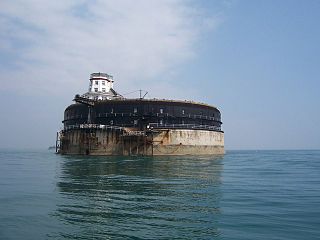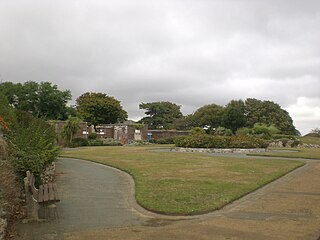
Spitbank Fort or Spitsand Fort or Spit Sand Fort or simply Spit Fort is a sea fort built as a result of the 1859 Royal Commission. The fort is one of four built as part of the Palmerston Forts constructions. Located in the Solent, near Portsmouth, England, and is now a luxury hotel.

No Man's Land Fort, also referred to as No Man's Fort, is a sea fort in the Solent, near Portsmouth, England. It is one of the Palmerston Forts built between 1867 and 1880 after the recommendations of the 1859 Royal Commission. It is 200 feet in diameter, and lies 1.4 miles off the coast of the Isle of Wight.

Horse Sand Fort is one of the larger Royal Commission sea forts in the Solent off Portsmouth, Hampshire, England. The fort is one of four built as part of the Palmerston Forts constructions. It is 200 feet (61 m) across, built between 1865 and 1880, with two floors and a basement and armour-plated all round.

The Royal Commission on the Defence of the United Kingdom was a committee formed in 1859 to enquire into the ability of the United Kingdom to defend itself against an attempted invasion by a foreign power, and to advise the British Government on the remedial action required. The appointment of the Commission had been prompted by public concern about the growing military and naval power of the French Empire and was instigated by the Prime Minister, Henry Temple, 3rd Viscount Palmerston, who came to be closely associated with the project. In the following year, the Commission's report recommended a huge programme of fortification to defend the country's arsenals and naval bases. Many of the recommendations were acted upon; however, the great expense, the length of time taken to complete the various works and their perceived usefulness were all subjects of critical political, press and public debate.

Fort Nelson, in the civil parish of Boarhunt in the English county of Hampshire, is one of five defensive forts built on the summit of Portsdown Hill in the 1860s, overlooking the important naval base of Portsmouth. It is now part of the Royal Armouries, housing their collection of artillery, and a Grade I Listed Building.

Fort Gomer was one of the Palmerston Forts, in Gosport, England, the southernmost and first-built Polygonal fort in the defence line to the west of Gosport. It was located on land immediately to the west of the present Gomer Lane. Fort Gomer was the most southerly fort in the line of five which formed part of the ‘Sea Front and Spithead Defences’, Inner Line, Land Front, Left Flank. This line of forts was later known as the Gomer-Elson Line or 'Gosport Advanced Line' This consisted of, from south to north, Fort Gomer, Fort Grange, Fort Rowner, Fort Brockhurst and Fort Elson. An inscription above the main entrance through the barrack block read `Erected AD 1853’. The fort was almost complete before work began on Fort Elson in 1855. The estimated cost of Fort Gomer was £92,000 in 1869.

The RML 12.5-inch guns were large rifled muzzle-loading guns designed for British battleships and were also employed for coast defence.

Hatherwood Battery is a battery located to the east of Alum Bay on the Isle of Wight. It is one of the many Palmerston Forts built on the island to protect it in response to a perceived French invasion. It was sited to cross fire with the nearby Needles Battery

Puckpool Battery is a battery located at Puckpool Point, close to the town of Ryde on the Isle of Wight. It is one of the many Palmerston Forts built on the island to protect it in response to a perceived French invasion. Construction of the battery began in 1863 and was completed by March 1865.

Redcliff Battery is a battery located to the west of the Culver Cliffs and east of Yaverland on the Isle of Wight, England. It is one of the many Palmerston Forts built on the island to protect it in response to a perceived French invasion. Construction of the battery began in April 1861 and was complete by September 1863 at a cost of £4,776. Most of it has fallen into the sea. Only small amount left May 2020

Sandown Fort is a fort built in Sandown on the Isle of Wight in the middle of Sandown Bay. It is one of the many Palmerston Forts built on the island to protect it in response to a perceived French invasion. It was a replacement of the earlier Sandown Diamond Fort as in 1859 the Royal Commission felt it did not offer suitable protection. Construction of the fort began in April 1861 and was completed by September 1864 at a cost of £73,876. In later documents it is often referred to as Granite Fort. The fort originally had 18 9-inch R.M.L guns facing the sea behind iron shields, these guns were later upgraded and an extra 5 inches of armor was added.

Sandown Barrack Battery is a battery located in Sandown Bay close to Sandown on the Isle of Wight in England. It is one of the many Palmerston Forts built on the island to protect it in response to a perceived French invasion.

Cliff End Battery is a battery on the west coast of the Isle of Wight overlooking Fort Albert. It is one of the many Palmerston Forts built on the island to protect it in response to a perceived French invasion. Construction of the battery began in 1862 and was completed by 1868 at a cost of £32,714.

Bembridge Fort is a fort built on the highest point of Bembridge Down close to the village of Bembridge on the Isle of Wight, England. It is one of the many Palmerston Forts built around Portsmouth during the period of the Second French Empire, as a safeguard against a perceived threat of French invasion by Napoleon III.

Culver Battery is a former coastal artillery battery on Culver Down, on the eastern side of the Isle of Wight, England. The fortification is one of several Palmerston Forts built on the island following concerns about the size and strength of the French Navy in the late 19th century. It was operational during the First and Second World Wars. The battery was closed in 1956.
Many forts and fortifications have been built to protect the Isle of Wight from foreign invasion. Throughout history the island has been a site of key military importance. Controlling both entrances to the Solent and the home of the Royal Navy, Portsmouth. This is a list of most of the fortifications on the island.

The Stokes Bay Lines were part of the great Victorian fortification of Portsmouth Harbour under Lord Palmerston. In 1857 Major Jervois had proposed a complex system of moats (ditches), ramparts and batteries to close off the gap between the new fort at Fort Gomer, and the earlier fort at Fort Gilkicker, and Fort Monckton. This defensive moat was to become the ‘Stokes Bay Lines’.
Fort Elson was one of the early Palmerston Forts, in Gosport, England, the northernmost polygonal land fort in the defence line to the west of Gosport. It was located on land immediately to the south of Elson Creek, to which it was connected by a sluice. Fort Elson was the most northerly fort in the line of five which formed part of the ‘Sea Front and Spithead Defences’, Inner Line, Land Front, Left Flank. This line of forts was later known as the Gomer-Elson Line or 'Gosport Advanced Line' This consisted of, from south to north, Fort Gomer, Fort Grange, Fort Rowner, Fort Brockhurst and Fort Elson. Work began on Fort Elson in 1855. The estimated cost of Fort Elson was £63,740 with the actual cost £61,180.

















